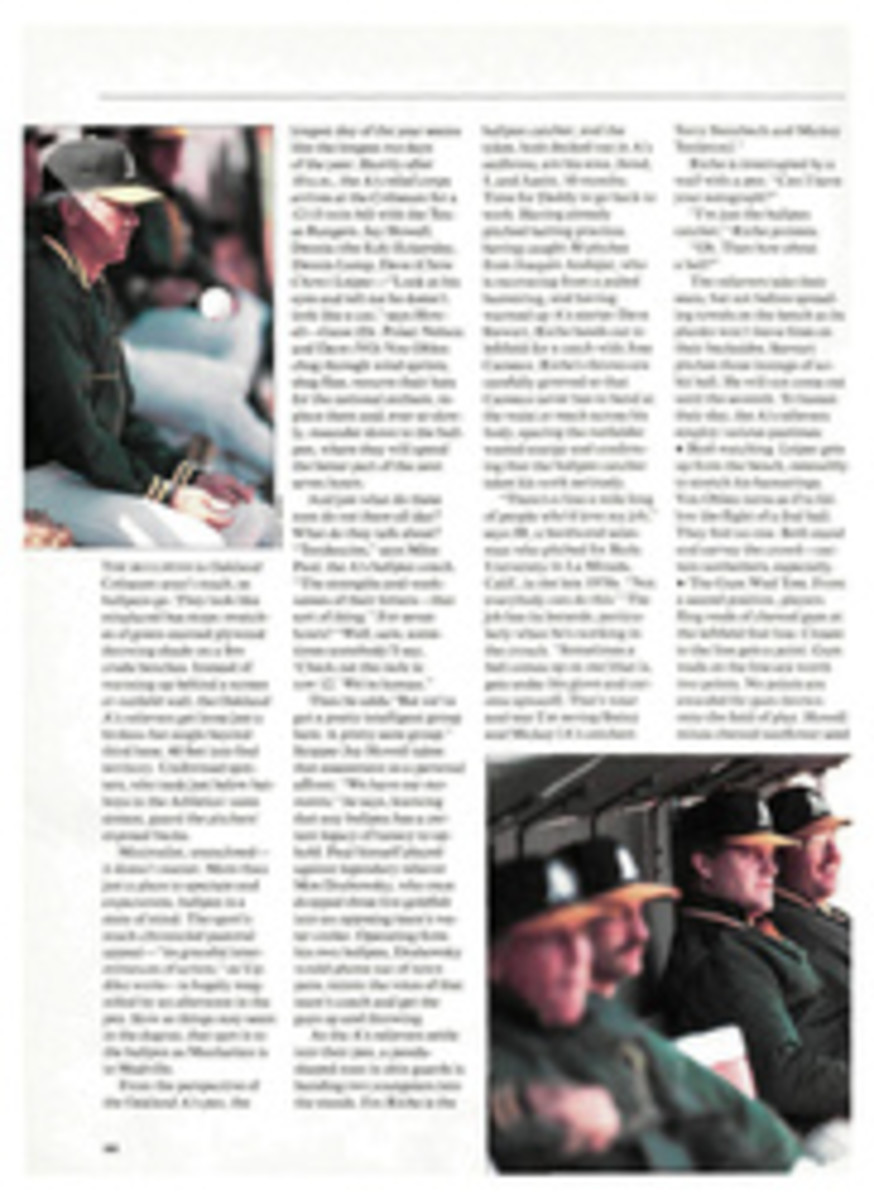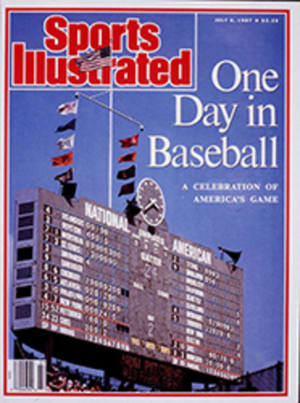
GOING, GOING...OOPS
In my dreams, the leftfielder never moves. He knows the ball is gone as soon as it leaves the bat. I have seen myself hitting that home run in Comiskey Park since I was a little boy.
I hit .167 in high school, though, and taking one out of Comiskey became an improbable fantasy. But then one day last spring, I saw John Cangelosi put one over the wall in Comiskey Park, and I began to dream again.
The 5'7", 150-pound Cangelosi was a rookie centerfielder with the White Sox last year. He was traded to the Pirates this season, but no matter; the point is that, at 5'10" and 175 pounds, I dwarf him. Cangelosi is the only one of the 624 big leaguers I would even consider challenging to an arm-wrestling match.
I knew what I had to do.
I won't bore you with details, but in a complex friend-of-a-friend-of-a-brother deal, I secured Comiskey Park all to myself for one morning. I had a chance to make my dream come true.
But before my Comiskey debut, I spent a lot of time at a batting cage near my apartment on Chicago's South Side, sharpening my stroke. Twelve cuts for 50 cents. The pack of local youths who loitered at the cages respected only those who dared Super-Fast, a nasty machine that sometimes went for the head. Stepping into the box against Super-Fast was a macho ritual. Me, I wasn't interested in proving my manhood. I was a 23-year-old dreamer there to get my timing down. I suffered their slings as I hacked away in Medium.
"Grown man, too," they would giggle. "Bet he can't touch Super."
I paid no attention. Concentration is the key to hitting. I knocked out 50 cents' worth, then 50 cents more, then one last 50. I left, sweating impressively, feeling strong.
As the big day approached, my workouts intensified. Five bucks' worth of balls a day. I also called Phil Cappelleri, my old high school baseball coach.
"I'm taking batting practice at Comiskey Park," I explained to him. "I think I can hit one out."
There was laughter at the other end, I kept my composure. Composure is the key to hitting.
I needed some last-minute coaching, I told Cappelleri. He thought for a moment, then said, "I'll tell you, Jim, your best chance is if you take two swings. Hit it. Pick it up where it lands. Hit it again." He seemed to be laughing again.
I went to buy my bat. I wanted a real piece of lumber, a menacing club. I moved past the smaller, slenderer sticks of wood to the final rack. There I found three models—a Ryne Sandberg, an Eddie Murray and a Dale Murphy.
Sandberg was out. Cubs bats don't belong in Comiskey Park.
I moved to Eddie Murray. Murray is probably my favorite ballplayer. Quiet and intense, he just does his job. A ballplayer's ballplayer. Which is exactly how I saw myself: "Becker don't shoot off his mouth much. And he don't like the press. But let me tell you, he can hit a baseball."
But Eddie Murray didn't feel right in my hands. So I moved to Dale Murphy. I fingered the skinny handle up to a barrel so thick you could whittle a canoe paddle from it. At 35 ounces, 35 inches, it was like hauling a telephone pole to home plate. And the bat—with its brown grain lines—was striped like a tiger. What a bat.
There was nothing left to do but hit.
The night before my big chance, I pulled an instructional book off my shelf and turned to the section on hitting. It was written by former Dodgers manager Walter Alston and began: "For a long time, I have felt too many hitters were swinging for the fences."
I tossed the book aside. I had one shot. With all due respect to Mr. Alston, I vowed to take the most vicious cuts imaginable. Then I turned in early, because that's what Dale Murphy would have done.
The next morning I phoned work, said my car had broken down, and met my friend Brian, who had agreed to pitch, for the ride to Comiskey. I rolled Dale Murphy in my hands as we puttered along in the rush hour. In the cars around us I saw the gloomy faces of people on their way to work. But I was on my way to hit. I felt good. I felt ready.
We pulled off 35th Street and parked on Shields Avenue across from the huge old white-and-green ballpark. I set Dale Murphy, my baseball mitt and four baseballs down and pounded on the door to the main entrance.
"I'm here to hit," I told the security man. Five minutes later I stepped through a gate on the third base side and was on the playing field.
Workers were sweeping the upper deck, and the grounds crew was lounging in leftfield. The grass was still moist with dew. I marched to home plate. The batter's box was wet and mucky, and two holes, made by hitters digging in with their cleats, were filled with clay. Home plate was gray, not white.
Head groundskeeper Roger Bossard later told me that the entire batting area is manicured and home plate is repainted each time the Sox return for a home stand. The club was on the West Coast and wouldn't be home for a week. Still I was a little hurt that they hadn't spruced things up for me.
I peered up from home plate, saw the scoreboard in centerfield, then looked over to the leftfield foul pole and the 347-foot marker. Three hundred forty-seven feet is a lot farther when you're standing at home than it is when you're sitting in the bleachers.
I swung Dale Murphy while Brian walked to the pitcher's mound with the glove and four baseballs. The grounds crew in leftfield looked in at us.
"Come with your heat," I said to Brian. Brian wound up and threw. The ball rushed in, a good pitch to hit. I took a mammoth swing, felt bat meet ball and heard a crack! that resounded through the empty ballpark.
Pop foul behind third.
Brian threw again, and I took another mighty swing. It produced a weak grounder that rolled through the infield and died in short left. The third pitch I missed completely, and it bounced unobstructed all the way to the backstop where some front office executives had gathered. I jogged back to retrieve the baseball. The men looked at me, but said nothing. One shook his head. I cleared my throat, picked up the ball and ran back to home plate.
Brian threw another batch of balls, and I hit four grounders to shortstop. By now the grounds crew saw what was going on and took fielding positions in the outfield. I dinked two pop-ups and two ground balls, then four more grounders. The grounds crew moved in. I felt desperate. This was my big chance. I had trained. But now I couldn't even get the ball in the air.
Bossard approached. "I'll get some of our jumped-up balls. You'll hit those out of here for sure."
"Really?" I asked hopefully.
Bossard laughed and put his hand on my shoulder. There were no jumped-up balls.
I returned to home plate. Brian pitched ball after ball, I swung as hard as I could, and nothing. I beat grounders into the dirt, popped up or hit soft line drives that barely cleared the infield before diving into the wet morning grass. The few I put good wood on began with a heroic crack! only to fall to earth in medium leftfield, a long way from glory.
The grounds crew was ready to fertilize the outfield, and I was given five more minutes. I fouled one back, then hit a short fly to center. "Come on, come on," I whispered to myself.
Brian wound up and threw heat. Inside fastball. I met it solidly. The ball shot over the imaginary third baseman's head and rushed down the line. It dropped directly on the foul line, kicking up the chalk, then rolled into the leftfield corner. A double in any man's ballpark.
"It's time," said a front-office man. We were led from the field, and the gate was pulled shut.
It was over. My boyhood dream of hitting a home run in Comiskey Park was gone forever. I was no John Cangelosi. I was no rookie phenom. I felt old.
I drove home.
That night I pictured myself years from now, talking about this day. "No, I never took one out of Comiskey Park," I would say. "But I hit a bullet down the line."
I saw again the baseball dropping perfectly on the foul stripe and the chalk puffs rising on either side as it skittered into the leftfield corner. A double in any man's ballpark. And I smiled for the first time since leaving Comiskey Park.
Not over the wall, but not bad. Not everyone is a phenom. I could live with that.
ILLUSTRATION
KEN JOUDREY
Jim Becker is currently writing a book about high school football in his native Chicago.

